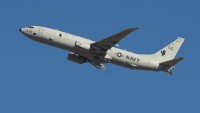US Navy: Full-blown Arms Race Looms in South China Sea
| Carlos Castillo | | Dec 17, 2015 09:16 AM EST |
(Photo : Getty Images/Ashley Pon) A Taiwanese soldier stands guard during a training exercise in Matsu, Taiwan. US Navy Admiral Scott Swift has warned that tensions in the South China Sea may degenerate into a full-blown arms race.
The commander of the US Pacific Fleet warned on Wednesday that a full-blown arms race looms over the South China Sea as tensions in the region have pushed countries to re-arm, muster their troops, and pour billions of dollars into additional weapons and warships.
While he fell short of accusing China of undermining the stability of the Asia-Pacific, US Navy Admiral Scott Swift said longstanding disputes in the South China Sea are challenging the maritime principle of freedom of the seas.
Like Us on Facebook
"Alarmed by these trends, claimants and non-claimants are transferring larger shares of national wealth to develop more capable naval forces beyond what is needed merely for self-defense," Swift said, adding that the arms build-up has precipitated regional instability.
The US naval commander made the statement in a speech delivered in a defense forum at the Naval War College in Hawaii. Swift's emphasis on Southeast Asia underlines the increasingly taut situation in the region.
Beijing has for some years made aggressive claims over the South China Sea, primarily through China's heavily-armed warships. Chinese troops are also now stationed on the much-contested Spratly Islands, where they have dredged sand to expand the surface area of the tiny coral reef ridge, reportedly to accommodate a runway and other military facilities.
This -- along with other activities apparently aimed at tightening China's grip on the resource-rich waters -- has both alarmed and incensed several nations in the region. Some of these countries have not only responded with legal action, but also with highly publicized military pacts and weapons deals with the US.
In November, two US B-52s flew near the artificial islands built by China, angering Beijing. A similar incident had taken place the previous month, when the USS Lassen sailed within 12 nautical miles of the disputed shoals. On both occasions, the US had invoked international laws to justify the presence of its forces in the region.
US naval planners appear to think the tension is bound to increase in the coming years. The Pentagon plans to send more than half of the combat ships in the US Navy to the Asia-Pacific over the next five years to counter China's growing military presence in the area.
In his speech, Swift urged multi-lateral negotiations to settle the on-going territorial disputes, saying, "With so many overlapping claims, how can two sides negotiate fairly without imposing on another claimant's equities?"
The situation is nonetheless complicated. All the claimants -- including Vietnam, Malaysia and Brunei -- have attempted to justify their claims based on their coastlines and the UN laws of the sea, with the exception of China.
Beijing's claim on the territory mirrors that of Taiwan, and goes back hundreds of years. Today, that claim is mainly based on a demarcation line -- the 'Nine Dash Line' -- that dates back to 1947, when Japan surrendered the Paracels, Pratas and Spratly islands to China.
Whether or not China will in fact enforce this decades-old claim militarily remains to be seen.
Recently, however, a state-owned Chinese newspaper is reported to have issued a subtly-worded threat to the Royal Australian Air Force after one of its surveillance planes flew over the disputed area.
"Everyone has to be careful," the paper is quoted by the Australian press as saying, "but it would be a shame if one day a plane fell from the sky and it happened to be Australian."
Tagsnine dash line, People's Republic of China, Australia, spy plane, Taiwan
©2015 Chinatopix All rights reserved. Do not reproduce without permission
EDITOR'S PICKS
-

Did the Trump administration just announce plans for a trade war with ‘hostile’ China and Russia?
-

US Senate passes Taiwan travel bill slammed by China
-

As Yan Sihong’s family grieves, here are other Chinese students who went missing abroad. Some have never been found
-

Beijing blasts Western critics who ‘smear China’ with the term sharp power
-

China Envoy Seeks to Defuse Tensions With U.S. as a Trade War Brews
-

Singapore's Deputy PM Provides Bitcoin Vote of Confidence Amid China's Blanket Bans
-

China warns investors over risks in overseas virtual currency trading
-

Chinese government most trustworthy: survey
-

Kashima Antlers On Course For Back-To-Back Titles
MOST POPULAR
LATEST NEWS
Zhou Yongkang: China's Former Security Chief Sentenced to Life in Prison

China's former Chief of the Ministry of Public Security, Zhou Yongkang, has been given a life sentence after he was found guilty of abusing his office, bribery and deliberately ... Full Article
TRENDING STORY

China Pork Prices Expected to Stabilize As The Supplies Recover

Elephone P9000 Smartphone is now on Sale on Amazon India

There's a Big Chance Cliffhangers Won't Still Be Resolved When Grey's Anatomy Season 13 Returns

Supreme Court Ruled on Samsung vs Apple Dispute for Patent Infringement

Microsoft Surface Pro 5 Rumors and Release Date: What is the Latest?











